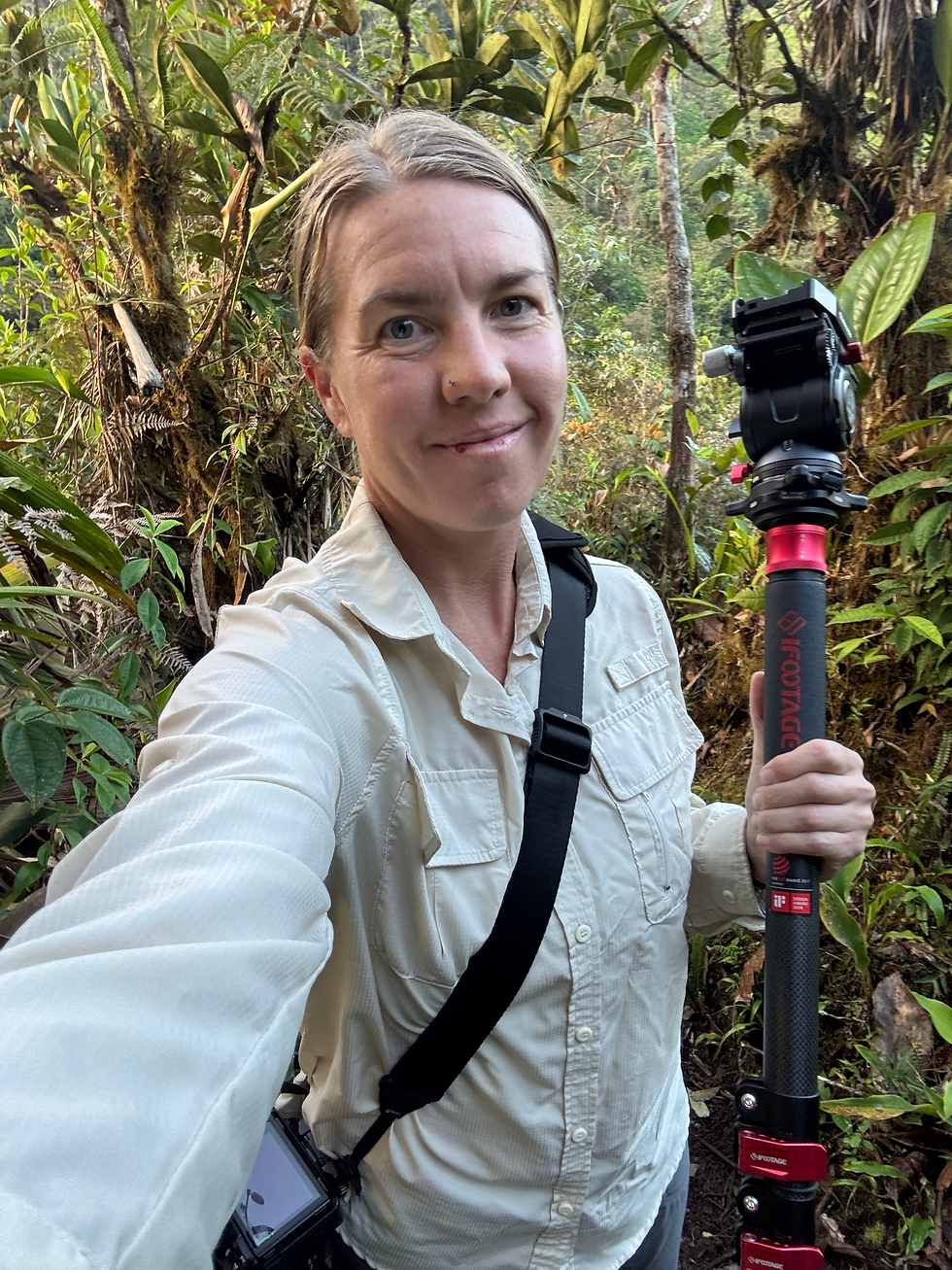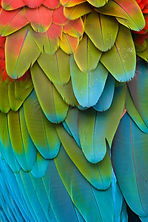A Morning in the Cloud Forest: Photographing the Andean Cock-of-the-Rock
- Overland Uncharted
- Aug 1
- 7 min read
Updated: Aug 3
There’s nothing like the chill of a cloud forest morning to wake you up—except maybe the electric calls of the Andean Cock-of-the-Rock echoing through the trees. Before the sun crests the ridgeline, we’re already on the trail, navigating mud, mist, and the thrill of what’s to come. This is bird photography at its wildest—and most rewarding. Whether you're an avid wildlife photographer, novice or serious birder, or just enjoy birdwatching, this is one species that will be a lifer for most everyone! The first step, however, is finding this iconic species...

Species Spotlight: Andean Cock-of-the-rock
Scientific Name: Rupicola peruvianus
Family: Cotingidae
Habitat: Humid montane cloud forests, typically at elevations of 1,400–2,400 meters
Range: Western Andes of Colombia, Ecuador, Peru, and northern Bolivia
Status: Least Concern (IUCN), but habitat-specific and sensitive to disturbance
Notable Behavior:
Famous for their lekking displays, where males gather at dawn to perform elaborate vocal and physical displays to attract females
Males are brilliantly colored in fiery orange-red with a disk-like crest covering the bill and forehead
Females are duller and more camouflaged, often seen nesting on cliff faces or rocky outcrops
📸 Photographing this bird is a bucket-list moment for any bird photographer—equal parts challenging and awe-inspiring.
Where to See the Andean Cock-of-the-rock
The Andean Cock-of-the-rock (Rupicola peruvianus) is one of South America's most iconic birds, known for its vibrant red-orange plumage and dramatic mating displays. It’s most often found in the humid cloud forests of the Andes, where moss-draped trees and steep valleys provide perfect cover for its hidden leks. While it's famously seen in Colombia, the species also ranges through parts of Ecuador, Peru, and Bolivia.
Best Places to See the Andean Cock-of-the-rock in Colombia: Jardín vs. Doña Dora
Colombia offers two of the best places to see the Andean Cock-of-the-rock: the easily accessible lek near Jardín and the more immersive, off-the-beaten-path experience at Doña Dora.
The Jardín Cock-of-the-rock lek is just a short walk from town with no hiking required, making it one of the most convenient spots in Colombia to photograph or observe this iconic bird. It’s ideal for travelers on tight schedules or those looking for easy access to stunning wildlife.

For a more in-depth birding adventure, Doña Dora offers a unique opportunity. Located just outside Jardín, this site requires a moderate uphill hike through lush cloud forest. The rewards are rich: not only are Cock-of-the-rock males often active here, but you’ll also have the chance to see a greater variety of cloud forest species—including Trogons, Toucan Barbets, and several colorful tanagers—that are not always present at the town lek.
In this post, we’re sharing our experience at Doña Dora—a place that gave us not only unforgettable views of the Cock-of-the-rock, but also surprise encounters with species we didn’t expect to see in one spot.
The Hike In: Dark, Damp, and Worth Every Step
We leave about 30–40 minutes before daybreak, headlamps cutting through the inky dark. The trail down to the lek is steep, wet, and often slippery, carved into the side of a lush, mist-wrapped hillside. Depending on your pace—and how surefooted you are—it can take anywhere from 20 to 30 minutes.
We made the trek down each morning during our multi-night stay at Doña Dora, and I only had to slip and fall once to learn my lesson: slow down. A tripod in one hand and a camera with a long lens in the other makes for a tricky descent, especially in the dark. Grippy boots and a good headlamp are non-negotiables. There are a few guide ropes and handholds, but with your hands full, grabbing them is easier said than done.
As we near the lekking site, the first signs of activity begin—strange, echoing croaks and calls ripple through the undergrowth. The forest is still dim, the outlines of trees now starting to take shape, and the air thick with anticipation. We arrive at a small photo blind—a simple shelter that offers front-row seats to one of the most dramatic bird displays on Earth; but at this hour, the light is still scarce, and the action is anything but slow. Our excitment overflows. In trying to keep calm, we set up our gear quickly. Thankfully, we had a multi-day stay here and which meant- more chances than one to get it right in the camera.
Which brings us to the real challenge...
Tips for Photographing Birds in Low Light & Motion
Photographing these lek displays is exhilarating—but challenging. The light is low, the action is fast, and the setting is often dense with foliage. Here’s how we adapted:

1. Go Fast—but Not Too Fast
Start with a shutter speed of around 1/500s to freeze motion during wing-flaps and jumps, then adjust as light improves. Don't be afraid to slow it down- the males tend to perch and hold still for a few seconds before jumping around again. A wider aperture (f/2.8–f/6.3) is essential in the pre-dawn gloom- open her up baby, shoot wide open! Our Nikkor 600mm PF only stops down to f6.3 but given then in-camera stabilization of the NikonZ8 and the vibration reduction technology built in to the lens, we were able to to get sharp images at shutter speeds as low as 1/13sec (w/use of a mono-pod)!!
2. Don’t Be Afraid of ISO
Push ISO to 3200, 6400, or 10,000+ if needed. Better to embrace grain than lose sharpness to blur. Today’s sensors handle noise surprisingly well in post. You can edit out noise, (espically with the advancing editing tools now-a-days) but you can't do much with a blurry image.
3. Pre-focus and Wait
Pick a favorite perch or “hotspot” the males seem to favor and do one of two things depending on your camera features: 1) pre-focus manually if it is too dark for your AF to pick up a subject and/or is too slow and hunts for the subject. OR 2) if your camera's AF modes are more sophiscated (as is the case with newer mirrorless lines), you may have luck setting it to the quickest AF mode your camera allows- we mainly use the Wide and 3D tracking AF modes on our NikonZ8 with bird set as subject detection. With that being said, the lens you choose will also affect your AF speed. Typically speaking, the faster the lens (the lower the aperature) the better suited you are for low light conditions. Another tip- let the birds come to your frame instead of chasing them through a viewfinder. Patience is a virtue.
4. Use Silent Shutter Mode
Lekking birds can be skittish. Switch to electronic shutter mode to minimize sound and keep your presence discreet (present in most all newer mirrorless bodies).
5. Frame with the Forest
Don’t fight the foreground—use foliage as a compositional tool. Layers of moss, branches, and diffuse light add atmosphere and depth to your shots.
6.no flash!
Leave the flash off—always. Not only can it startle or stress the birds (especially during critical courtship displays), but it can also disrupt the experience for others in the blind. Low-light birding requires patience and respect. Everyone’s there for the same quiet magic—let’s keep it that way.
Scroll right: pic 1) check those settings! 1/20 sec f6.3 ISO 2200 -> pic 2) raw unedited image straight out of camera -> pic 3) minimally edited final image
Gear We Used

Camera:
raw BTS footage shot with DJI Action 5 Pro and iPhone16 ProMax
Lens(s):
Tripod:
IFOOTAGE COBRA2 C180 ii MONOPOD w/ IFOOTAGE Viedo Tripod Head
FLM CP26-Travel II 10X Carbon Fiber Series II Tripod w/NEEWER fluid head
Rain Cover: Essential for lens protection—cloud forest mist turns to drizzle fast
Disclaimer: This post contains affiliate links to Amazon. If you click through and make a purchase, we may earn a small commission at no additional cost to you. Thank you for supporting our work!
Not Just a Hike—A Second Photo Opportunity
After the lekking winds down and the light brightens, it's time to head back up the trail— a dreaded hike given the steep climb down. But, now there is plenty of light and...there’s one more treat in store.
Halfway up the climb, you'll find a second photo blind: a tarp-covered clearing with both a black light and another warm light left on through the night. The glow attracts insects, which in turn bring in an incredible diversity of birds.

This mid-trail blind is a photographer’s bonus round—and a very welcome one. There are chairs, water, and snacks, and it’s the perfect place to catch your breath and wipe away the sweat (because yes, it’s very humid).
One morning, we watched a Squirrel Cuckoo dive from the shadows to snatch a moth from the tarp—wildlife photography at its most spontaneous. Easy pickens. Work smart, not hard they say ;)
Just another brilliant reason to visit this birding hotspot in the Valle del Cauca department of southwestern Colombia.
Fueling Up and Looking Back
By the time we reach the lodge again, it’s hard to say what’s more welcome: the hot coffee and empanadas, or the sense of accomplishment. There’s something magical about photographing rare birds before breakfast. Something even more magical about doing it all again tomorrow. And for the kicker- we enjoy breakfast with a vast array of tanagers, hummingbirds, and other color birds also feasting at the well constructed feeders just feet in front of our plates. What a treat, literally.

Want to Experience It for Yourself?
Our Colombia bird photography tours take you to places like Doña Dora, where wildlife, expert guidance, and unforgettable moments come together. Experience the magic of the Andean Cock-of-the-Rock with us on our next tour!

Every image of a bird you see on our website was taken by us on real tours—no stock photos here. We believe in showing you the genuine beauty of the places we explore, birds we encounter, and moments we share. Please ask before using any of our photos—we're proud of our work and love to keep it personal.










Comments